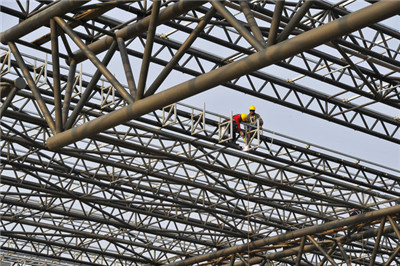HONG KONG — China’s economy grew in the first three months of 2015 at its slowest quarterly pace in six years, dragged down by an industrial slowdown and a weak housing market, the government announced Wednesday.
香港——中国政府周三宣布,由于工业增长放慢、房地产市场回落等因素,2015年第一季度国内经济增速跌至六年来最慢。
Gross domestic product rose 7 percent from a year earlier, in line with economists’ forecasts. While the growth rate means China still ranks as one of the world’s fastest growing major economies, it marked the country’s slowest quarterly expansion since early 2009, when it was still feeling the effects of the global financial crisis.
一季度GDP与去年同比增长7%,符合经济学家们的预期。尽管这一数值仍能保证中国跻身全球增长最快的经济体之列,但同时也标志着中国进入了自2009年全球经济危机以来增长最慢的一季度。

China’s Communist Party leadership has lowered its official growth target for this year to around 7 percent. This would be the nation’s slowest annual expansion in 25 years, but leaders have said this is a price that needs to be paid in order to reduce the economy’s reliance on credit-fueled growth and get everyday shoppers to spend more of their savings.
中国共产党领导层将今年官方的经济增长指标下调至7%左右,为25年来最低。但领导人表示,这是为了减少对信贷刺激增长的依赖性并拉动日常消费所必须付出的代价。
Recent indicators suggest that the economy could be slowing more rapidly than many observers expected. In March, industrial production rose 5.6 percent from a year ago, its slowest increase since late 2008. Land purchases by real estate developers plunged 32 percent by area in the first three months of the year.
最近的指标表明中国经济增长的放缓可能比许多观察员所预期的更快。3月,工业生产同比增长5.6%,创2008年来新低。而房地产开发商一季度的土地购买量按面积算下跌32%。
Premier Li Keqiang told a forum of Chinese economists on Tuesday that economic performance in the first quarter “has a strong role as a weathervane,” according to a report in the Beijing News newspaper.
据《新京报》报道,中国总理李克强在周二某经济学家论坛上表示,一季度的经济指标“有很强的风向标作用。”
The pace of growth in the first quarter “supported quite ample employment, and residents’ incomes have also risen in step,” the Beijing News said, summarizing Mr. Li’s comments.
一季度增速“支撑了比较充分的就业,居民收入也同步增长,”新京报总结李克强的评论说。
“But on the other hand we must see that downward economic pressure indeed continues to grow,” Mr. Li said. “Some of our traditional sources of strength are receding, and at the same time there are newly emerging sources of growth, and some sunrise industries are experiencing explosive growth.”
“但另一方面必须看到,经济下行的压力的确在持续加大,”李克强说。“我们一些传统的支撑力量正在消退,与此同时,一些新兴力量则在成长,有的新业态新产业呈爆发式成长。”
For example, retail sales in March rose 10.2 percent, the slowest increase in nearly a decade. But online merchandise sales increased 41 percent in the first quarter, and now account for about 9 percent of all sales of consumer goods in China.
例如,3月份零售额增长10.2%,为10年来最低。但网上商品销售额一季度增长41%,已占中国消费品总销售额的9%左右。
Foreign trade, by contrast, has been buffeted by lackluster overseas shipments and signs of even weaker demand at home. Exports of goods by value rose only five percent in the first three months of the year, while imports slumped 17 percent, weighed down by lower global prices for oil and other commodities.
相比之下,对外贸易则在惨淡的海外出货和更惨淡的国内需求的影响下遭受重创。一季度出口价值总量仅增长5%,而由于全球油价及其他商品价格的跌落,进口量大幅下降17%。
The housing market continues to struggle, with home prices falling and new construction starts declining. This has far-ranging effects at home and abroad, including on domestic steel production, pricing of imported iron ore from Australia and the employment of sales agents at property brokerages across China.
随着房价的下跌和房屋新建工程的减少,房地产市场依旧呈现低迷态势,对国内外均造成深远影响,包括国内钢铁生产、对澳大利亚进口铁矿石定价和中国各地房地产经销商对销售代理的雇佣。
Sheng Laiyun, the spokesman for China’s National Bureau of Statistics, said that “downward pressure” on the Chinese economy came from both external factors, including the tepid recovery of many economies, and also from domestic factors. New sources of growth were emerging, he said, “but in the short term it’s difficult for them to make up for the subsiding of traditional drivers.”
中国统计局发言人盛来运表示中国经济的“下行压力”同时来自如各方面经济复苏缓慢的国际因素,和国内因素两方面。新动力的确在孕育,他说,“但短期内仍旧难以弥补传统动力消退所带来的影响。”
China’s leaders have responded to the slowdown by easing monetary policy but have held off from introducing more aggressive stimulus measures. Since November, the central bank has cut interest rates twice and freed up banks to lend more. Most economists expect further cuts in the coming weeks or months.
中国领导层为应对经济增速的放缓放宽了货币政策,但迟迟未进一步采取更激进的刺激措施。11月来,央行进行了两次降息并放宽了银行的放贷能力。大多数经济学家预计未来几周或几月内将迎来再次降息。
These measures do appear to be having an effect, with key short-term borrowing rates in China’s money market, an important indicator of the real cost of funding for smaller banks and other financial institutions, falling to around 3 percent in the past week, down from around 5 percent in February.
这些措施似乎在短期内卓有成效,短期借款利率从2月份的5%左右下降至上周的3%左右。短期借款利率是为规模较小的银行和其他金融机构融资的实际成本的重要指标。
Despite this, there are still few signs that the government’s efforts at weaning the country off of credit fueled growth are succeeding. Total credit growth has slowed in recent months, but it is still outpacing G.D.P. growth, meaning China as a whole is growing more indebted. The biggest factor here continues to be the increase in corporate borrowing.
尽管如此,仍然没有什么迹象表明政府让国家摆脱信贷刺激增长的模式的努力取得了成功。近几个月,贷款总额的增长速度放缓,但仍然快于GDP的增速,这意味着中国在整体上欠债更多了。最大的因素仍然是公司贷款的增加。
In his remarks on Tuesday, Mr. Li emphasized that the government would persist with planned economic and financial overhauls despite slowing growth.
在周二的讲话中,李克强强调,尽管增速放缓,但政府将坚持计划中的经济金融改革。
“Our toolbox still has many policy tools, and the biggest tool is reform,” Mr. Li said. “There certainly is pressure now, and the pressure on some sectors is quite heavy. But there is also impetus, and many businesses take a positive long-term view of this market,” he added.
“我们的‘工具箱’里还有不少政策工具,而最大的工具就是‘改革’,”李克强说。“当前确有压力,甚至在一些行业的压力还比较大。但也有动力,多数企业长期看好这个市场。”













